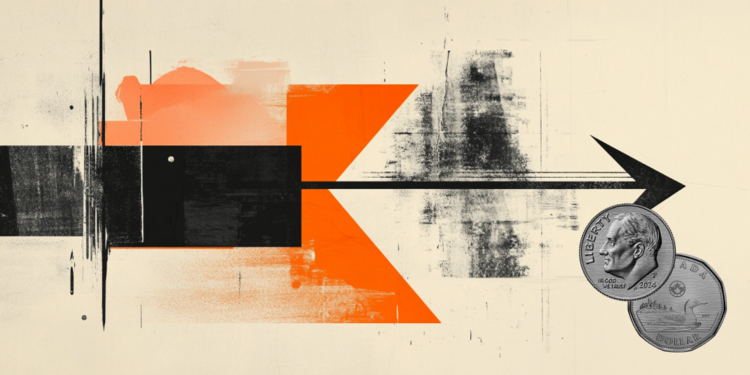- The US dollar advances after the publication of the CPI.
- Traders who were betting on a rapid drop in rates are left behind in the current conditions of strong inflation.
- The Dollar Index moves away from 102 and approaches 103.
He US dollar (USD) survives another day after mounting pressure throughout the week to break down the 102 level on the US Dollar Index (DXY). Bets in favor of new and faster disinflation figures, putting downward pressure on the Dollar. This inflation data confirms the US Federal Reserve's stance, warnings and correct assessment of keeping rates stable for now and waiting for more data before issuing rate cuts.
In addition, operators also had to evaluate the unemployment benefit application numbers. Although disinflation was about to stop, the labor market appears to remain very tense. Although initial jobless claims were expected to increase, they remained unchanged.
Even taking into account the previously revised number of initial jobless claims, there is a decline. Markets are reducing bets that rate cuts would come sooner, while commodities are rising. The energy component was expected to be a disinflationary element, although in this inflation report it turned out to be a contribution to the rebound in general inflation.
Daily Market Summary: Energy Component Is Biggest Surprise for Headline Inflation
- As expected, some fireworks with the data release starting at 13:30 GMT:
- United States Consumer Price Index:
- The monthly headline CPI was expected to move from 0.1% to 0.2%. Instead, it went from 0.1% to 0.3%.
- The annual headline CPI was expected to rise from 3.1% to 3.2%. The index rose to 3.4%.
- The monthly core CPI remained stable at 0.3%.
- The annual underlying CPI had to go from 4% to 3.8%. The actual figure was 3.9%.
- The dollar recovered after the release of this data, as bets on disinflation were undone and the chances of the Fed cutting interest rates in March were reduced.
- Publication of unemployment benefit applications:
- Initial jobless claims were expected to rebound from 202,000 to 210,000, although they remained unchanged at 202,000, and were even revised up to 203,000 the previous week.
- Continuation Requests were expected to increase from 1,855 million to 1,871 million. Instead, it was reduced to 1.834 million.
- United States Consumer Price Index:
- US stock markets are not digesting the US CPI report very well. The expected Goldilocks scenario is not happening (at the moment). The main US indices have fallen by more than 0.50%, and European stocks have also reversed their trend and are selling at the close.
- CME Group's FedWatch tool shows that markets are pricing in a 97.4% chance that the Federal Reserve will keep interest rates unchanged at its Jan. 31 meeting. Around 2.6% expect the first cut to occur now.
- The 10-year US Treasury yield is back above 4%, sitting at 4.04%, and traders are selling bonds thinking rates will remain stable for at least another three months.
Dollar Index Technical Analysis: The Fed Was Right, So Listen Next Time!
The US dollar proved to be a textbook example of “buy the rumor, sell the fact.” Expectations that American disinflation would pick up speed and sink further were too high and too high. With big bets placed on quick cuts in early 2024, those bets need to be undone, resulting in favor of the dollar and US rates in general, while stocks fall out of favor for now.
The first bullish level to watch is 103.00, which falls almost in line with the trend line from the high of October 3 and December 8. If it breaks and closes above, the 200-day SMA at 103.43 comes into play. The 104.00 level could be too far away, with 103.78 (55-day SMA) as the next resistance.
On the downside, a rejection of the descending trend line would give wings to the Dollar bears and trigger a new recession. The line in the sand is 101.74, the bottom it held in mid-December before the breakout of the last two weeks. Should DXY break above this level, expect the low near 100.80 to be tested.
<
US Dollar FAQ
What is the US Dollar?
The United States Dollar (USD) is the official currency of the United States of America, and the “de facto” currency of a significant number of other countries where it is in circulation alongside local banknotes. According to 2022 data, it is the most traded currency in the world, with more than 88% of all global currency exchange operations, equivalent to an average of $6.6 trillion in daily transactions.
After World War II, the USD took over from the pound sterling as the world's reserve currency.
How do the decisions of the Federal Reserve affect the Dollar?
The single most important factor influencing the value of the US Dollar is monetary policy, which is determined by the Federal Reserve (Fed). The Fed has two mandates: achieve price stability (control inflation) and promote full employment. Your main tool to achieve these two objectives is to adjust interest rates.
When prices rise too quickly and inflation exceeds the 2% target set by the Fed, the Fed raises rates, which favors the price of the dollar. When Inflation falls below 2% or the unemployment rate is too high, the Fed can lower interest rates, which weighs on the Dollar.
What is Quantitative Easing and how does it influence the Dollar?
In extreme situations, the Federal Reserve can also print more dollars and enact quantitative easing (QE). QE is the process by which the Fed substantially increases the flow of credit into a clogged financial system. This is an unconventional policy measure used when credit has dried up because banks do not lend to each other (for fear of counterparty default). It is a last resort when a simple lowering of interest rates is unlikely to achieve the necessary result. It was the Fed's weapon of choice to combat the credit crunch that occurred during the Great Financial Crisis of 2008. It involves the Fed printing more dollars and using them to buy US government bonds, primarily from financial institutions. QE usually leads to a weakening of the US Dollar.
What is quantitative tightening and how does it influence the US dollar?
Quantitative tightening (QT) is the reverse process by which the Federal Reserve stops purchasing bonds from financial institutions and does not reinvest the principal of maturing portfolio securities in new purchases. It is usually positive for the US dollar.
Source: Fx Street
I am Joshua Winder, a senior-level journalist and editor at World Stock Market. I specialize in covering news related to the stock market and economic trends. With more than 8 years of experience in this field, I have become an expert in financial reporting.







